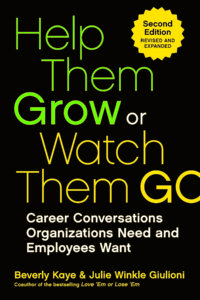Help Them Grow
Julie Winkle Giulioni partners with organizations worldwide to improve performance through leadership and learning. Named one of Inc. Magazine‘s top 100 leadership speakers, Julie is the co-author of the international bestseller Help Them Grow or Watch Them Go: Career Conversations Organizations Need and Employees Want.
After reading the newly updated edition of her book, I reached out to Julie to hear her latest perspectives on leadership and career development.
Retain Top Talent
Why is career development more important today than it was when you wrote the first edition?
Career development has always been important. It traditionally has been (and continues to be) among the top reasons people give for joining or leaving an organization. But since writing the first edition of Help Them Grow or Watch Them Go: Career Conversations Organizations Need and Employees Want nearly seven years ago, career development has risen to become a top priority – for individuals and organizations.
Low unemployment rates have led to a highly competitive talent market. The Conference Board predicts talent shortages in key sectors over the next 15 years and in a recent survey identified that “…attracting and retaining talent ranks as the foremost concern not only among CEOs but also the rest of the C-Suite, including CHROs and CFOs.”
Organizations are coming to understand that career development is a powerful strategy for retaining top talent. They also recognize that recruiting is easier and more effective when they have a reputation for developing talent. And—for better or worse— given the visibility that social media facilitates, candidates are making choices based upon an organization’s reputation for staff growth and development.
The Biggest Mistake Leaders Make
What mistakes do managers often make in developing employees?
The biggest mistake leaders make is simply not doing it. In my interviews of thousands of employees, very few report that their managers fouled up when it came to development. But the vast majority do report an absence of effort in this regard.
And from the manager’s perspective, there are a lot of seemingly good excuses for this.
- They’re swamped and don’t have the time. (In truth, busy managers don’t have time NOT to develop others.)
- Many are concerned that if they help people grow, employees will move on to other roles. (If they don’t, they’ll likely lose talent more quickly and struggle to recruit replacements due to a development-stunting reputation.)
- A lot of leaders are afraid to open the door to career conversations, fearing that employees want promotions and raises – which aren’t readily available. (Only about 25% of the US working population has that next promotion in mind. And our research with employees found that what people want more than anything from a career conversation with the boss is ‘creative ways to use skills and talents.’)
What are a few simple recommendations you would make to a new manager to make sure that he or she is helping employees grow?
New managers (and seasoned leaders as well) need to understand that helping people grow is a human rather than human resources activity. Too frequently, it’s the paperwork, forms, processes, and structures that get the attention… at the expense of genuine development.
Effective leaders certainly comply with internally-driven processes, but they understand that career development is not ‘one and done.’ Employees don’t grow as a result of an annual conversation. Growth happens a little bit, every day, over time, through ongoing dialogue. As a result, effective developers find ways to break it up and embed small doses of development (and the conversations that drive it) routinely in their interactions with others.
The other hallmark of effective developers is their ability to help others grow right in place – in their current role. Too frequently, we equate career development with a promotion or lateral move. We’ve gotten ourselves all tangled up in titles. In today’s flatter organizations, mobility may simply not be possible; but that doesn’t mean that development isn’t. The key is to find creative ways to invite development experiences into the envelope of one’s current role. This represents a doable way to facilitate growth as well as greater engagement and job satisfaction.
The Ideal Manager
Tell us about the ideal manager who grows people with excellence. What defines that person? What does he or she do that makes others want to join the team?
Talent magnets – the managers who are able to attract and retain top talent – tend to have mastered two fundamental development practices. They know how to cultivate conversation and engineer experiences.
I’ve asked literally thousands of leaders around the world about the people who helped them grow most and what specifically they did. And the overwhelming theme in what I hear revolves around relationship and dialogue. The ‘ideal’ manager engages in ongoing conversation, day-in and day-out. They get to know their people, their strengths, opportunities to improve, interests and aspirations. They facilitate dialogue that connects people to the big picture and helps them take action to move forward and toward their unique definitions of career success. They understand that talk is not cheap – but rather, one of the most powerful tools they have for facilitating growth.
These ideal leaders then use the repository of what they’ve learned about their team members to engineer and co-create development experiences for others. They don’t wait for a training program or formal activity, rather they seek out and/or invent opportunities for shadowing, exposure, visibility and organic growth through projects and stretch assignments.
In this way, a manager can encourage individual growth and development. But, at the same time, the team, department and organization benefit from enhanced capability and engagement.
Is it possible to develop a career development culture? If so, what does it look like?
Not only is it possible, it’s necessary to cultivate a career development culture. When culture aligns with and supports development, it creates a synergist tsunami, sweeping layers of leadership, policies and practices and fundamental sensibilities up and washing it all over the organization. Stragglers can’t hold out for long. They either join in or choose to go elsewhere.
And, in the process, the organization as a whole reaps the benefits of highly effective career development, engagement, customer satisfaction, discretionary effort, sales, innovation, retention, quality, productivity, reputation, loyalty, profitability….and the list goes one.
My field research suggests that cultures that actively support career development and enjoy its constructive biproducts share some fundamental characteristics or cultural markers. They tend to be:
- Information-rich – offering the open, transparent flow of information people need to own and proactively drive development
- Curious – with a focus on inquisitiveness, questions, inclusion of diverse points of view, and exploration of ideas
- Patient (with the development process) – reflecting an understanding that growth takes time, flexibility, commitment and consistency
- Results-oriented – demonstrating crystal clarity about ‘what’ needs to be done, but flexibility about ‘how’ to do it, thus enabling experimentation and growth
- Blurry around boundaries – bringing a spirit of generosity to development, sharing resources and even being willing to lose good people in service of their growth
For more information, see Help Them Grow or Watch Them Go: Career Conversations Organizations Need and Employees Want.


